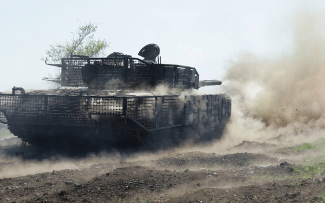Russian advances south of Kostiantynivka. Day 1182 of the war

![]()
The Russians widened the advance in the Ukrainian grouping along the Pokrovsk–Kostiantynivka road, seizing more villages on either side of it. As a result of this move and the operations conducted from the Toreck agglomeration, the Ukrainian grouping south of Kostiantynivka found itself in a salient, partially broken in two by a Russian strike towards the village of Zoria. Russia’s moves on the flanks threaten to encircle the grouping. It is to be expected that, if an effective counterattack cannot be mounted, the Ukrainians will gradually begin to withdraw to the immediate foothills of Kostiantynivka. Currently, the Russians are carrying out operations in the direction of this town from three directions: Chasiv Yar (north-east), Toretsk (south-east) and Pokrovsk (south-west). They have the shortest distance to cover from the side of the first of these settlements (less than 5 km along the Bakhmut–Kostiantynivka road), however, the defence in this area still remains relatively strong and Russia’s advances are small.
Russian forces have threatened the eastern flank of the Ukrainian grouping near Pokrovsk and Myrnohrad, striking west along the road linking that town to Kostiantynivka. They attacked from two sides the village of Novoekonomichne, the capture of which would allow them to half encircle Myrnohrad. No significant change in the situation, however, was brought about by Russia’s further field advances between Pokrovsk and Velyka Novosilka (the defenders withdrew from the local Bahatyr road junction), east of Siversk and north of Lyman.
The Russians pushed the Ukrainians out of positions in the Kursk and Belgorod oblasts immediately adjacent to the border, while seizing more territory in Sumy Oblast. An approximately 10 km2 stretch of Russian territory west of Tyotkino, mostly marshy and separated from the rest of Kursk Oblast by the floodplains of the Seym River, probably remains under Ukrainian control. The Ukrainians entered it as recently as last August, but due to the terrain conditions it did not form the basis of a further strike and no fighting took place there.
![]()
On 18 May, Russia launched a massive drone attack on Kyiv and Kyiv Oblast. According to Ukrainian sources, they used a total of more than 150 ‘Shaheds’ in it. Damage occurred in two areas of the city. The capital was also targeted by enemy drones on 16 May. Massive attacks occurred in western Ukraine – on 14 May in the Rivne and Ternopil oblasts, and a day later in the Ivano-Frankivsk and Volyn oblasts (drones hit Ivano-Frankivsk and Lutsk, among others). Furthermore, on 14 May, Russia targeted Kirovohrad Oblast and its capital Kropyvnytskyi.
The intensity of Russian air strikes on the immediate Donbas frontline has increased. On three occasions (16, 19 and 20 May), a massive drone attack affected the Kramatorsk industrial region. Drones struck Kharkiv twice (13 and 20 May), and on 19 May completely destroyed a business in Shostka in Sumy Oblast. In turn, the Sumy and Dnieper industrial infrastructure was hit by ballistic missiles (14 and 16 May respectively).
According to Ukrainian data, from the evening of 13 May until the morning of 20 May, Russia used a total of 922 strike drones and their imitators and just three missiles. A total of 415 drones are thought to have been downed and 334 locationally lost. Since 19 May, the Ukrainian Air Force Command has once again changed the formula for reporting attacks – it reports the total number of ‘neutralised’ drones (shot down and locationally lost and/or incapacitated by means of electronic warfare, which are still specified in the communiqués). This should be linked to the decline in the effectiveness of the air defence there, which has been observed for several weeks.
![]()
As a result of a massive attack by drones on Crimea on 16 May, a fire occurred at the ammunition depot of the Russian 126th Coastal Defence Brigade in Perevalne. No major damage was confirmed, but it was nevertheless the first successful strike by the Ukrainians against a military target on the peninsula since last year.
![]()
Australia has begun the transfer of 49 M1A1 Abrams tanks withdrawn from service to Kyiv, as confirmed by Prime Minister Anthony Albanese on 19 May. While the US has agreed to this step, it has warned of problems with the maintenance and operation of the Abrams by the Ukrainian side. It is unclear whether the tanks loaded on the ship will be diverted immediately to their intended destination, or whether they will undergo standard maintenance and possible repairs in the US beforehand. Taking into account preparation and training issues, they are expected to arrive at the frontline in the summer at the earliest. Deliveries from Australia will allow the reconstitution of an Abrams-equipped tank battalion in the elite 47th Mechanised Brigade and the formation of additional companies. According to the Oryx portal, the battalion has lost 22 of the 31 tanks delivered from the US in autumn 2023.
Norway will complete the delivery of the pledged F-16 fighter jets to Kyiv this year, Defence Minister Tore O. Sandvik announced on 15 May. He indicated that some of the aircraft had already been handed over, but gave no details, citing security concerns. According to some sources, Norway is expected to send up to 12 aircraft in total, and the already-delivered units have gone not to Ukraine, but to the European F-16 Training Centre (EFTC) for Ukrainian pilots in Romania.
By the end of the year, Belgium will provide €1 billion worth of military aid to Ukraine, of which €645 million is earmarked for purchases in the Belgian defence industry. As the daily De Tijd reported on 17 May, this will include one Leopard 1A5 tank, 20 upgraded Cerberus anti-aircraft systems and more than 16,000 pieces of other weaponry, including artillery. On the same day, the assumptions of the 11th Italian military aid package were presented for approval by the country’s defence ministry. According to the daily Il Giornale, the package would include a satellite reconnaissance system and 400 M113 tracked transporters which have been taken out of service.
Scheduled for 2025–2028, the 26th Danish military support package will be worth €546 million. The Danish Ministry of Defence announced on 18 May that it will include artillery and ammunition purchased under the so-called Czech initiative. Poland’s preparation of the 47th package for the Ukrainian army, worth €200 million, was announced on 16 May by the Polish ambassador Piotr Łukasiewicz in an interview with the Ukrainian daily European Pravda.
![]()
On 13 May, the Ukroboronprom corporation launched the ‘Return of Ukrainians’ programme in Poland, aimed at Ukrainians residing abroad who want to return to the country and take up employment in defence companies. The initiative aims to support especially those with experience and knowledge useful in the defence sector. The offer includes stable employment and social security as well as deferment for military conscription.
On 15 May, the Kyiv authorities increased funding for the ‘Defender Kyiv’ programme (which supports the budgets of the security and defence forces) by an additional 500 million hryvnias (about $12 million). The capital’s mayor, Vitali Klitschko, stated that 5.5 billion hryvnias (more than $130 million) had already been transferred from the city’s budget for this purpose since the beginning of the year.
One day later, the Ukrainian Ministry of Finance reported that budget expenditure to cover military benefits in April this year amounted to 329.9 billion hryvnias (approximately $7.8 billion).
On 17 May, the Ministry of Defence of Ukraine announced that more than 333,000 mobilisation deferrals had been issued through the Reserve+ application. Deputy Minister for Digitalisation Kateryna Chernohorenko stressed that one in every three of these permits is granted through this application. It facilitates applications for deferrals for people with disabilities, those with a pension certificate, full-time and postgraduate students, doctoral students and parents raising at least three children under the age of 18 and married.
The digitalisation of military records is progressing. Within six months of the introduction of the possibility to apply for a change of place of service in the Army+ application, more than 100,000 reports have been entered into the system and 32,000 soldiers have already been assigned to new units. The changes allow soldiers to transfer to where they can use their skills most effectively, and also provide a method of maintaining morale if, for example, a soldier comes into conflict with a superior.
A crisis in the way the army it commands units at the front is emerging. On 16 May, Lieutenant Colonel Bohdan Shevchuk, commander of the 59th Independent Assault Brigade of the Unmanned Systems Force, was removed from his post. The decision was taken by Commander-in-Chief of the Armed Forces of Ukraine Oleksandr Syrskyi. Shevchuk links his resignation to the difficult situation on the Pokrovsk direction and his independent order to withdraw personnel from positions to avoid encirclement, which did not meet with the approval of his superiors.
On 17 May, the battalion commander of the 47th Independent Mechanised Brigade “Magura”, Oleksandr Shyrshyn, publicly accused the command of ordering “stupid tasks” in Kursk Oblast, which in his opinion leads to unjustified casualties. He reported that he had filed a report demanding that he be removed from his post. In the statement, he criticised “political games” and the lack of correspondence between the command’s assessments and the brigade’s actual situation and combat capabilities. He stated that mid-level commanders “tremble in front of stupid generals” and that this attitude leads to failures, and that there is an abuse of disciplinary measures to force the execution of a questionable order. Shyrshyn’s attitude was met with disapproval by several unit commanders, who acknowledged the flaws in the command system, but at the same time announced that publicising the problem in the media supports Russian propaganda. The commander of the 225th Independent Assault Regiment, Major Oleh Shyryaev, appealed to the commander-in-chief to impose ‘severe restrictions’ on the public discussion of combat missions, the conduct of operations and command evaluation.
![]()
On 15 May, General Andrey Mordvichev (born 1976) was appointed as Commander-in-Chief of the Land Forces of the Russian Armed Forces. During the aggression against Ukraine, he became known as one of the most capable commanders. Among other things, he led the capture of Mariupol (in 2022) and Avdiivka (in 2024). Prior to his new post, he was commander of the Central Military District and, as part of the so-called special military operation, of the ‘Centre’ grouping, whose area of operations is the Donbas. Mordvichev’s predecessor as Commander-in-Chief of the Land Forces – General Oleg Salyukov – was promoted to Deputy Head of the Russian Security Council.
On 14 May, the Ukrainian defence ministry reported that Russia is using around 200 satellites and 150,000 personnel to operate space systems in the war. The latter figure reflects the size of the entire Air and Space Forces of the Russian Federation, most of which, however, are military aviation and ground-based air defence components. Ukraine, on the other hand, has one satellite – a ‘people’s satellite’ from the ICEYE company, purchased due to fundraising by the Serhiy Prytula Charitable Foundation. Support from partners means the army there is able to counter threats, but the defence ministry stresses the need to develop its own space capabilities.
During a videoconference of the Ukraine-NATO Council on 16 May, General Syrskyi reported that Russia has committed a force of 640,000 troops to its aggression.
Also on 16 May, Ukraine’s Foreign Intelligence Service announced that Russia was facing a manpower crisis in the economy. In 2024, there is a shortfall of 2.6 million people there. If current trends continue, the deficit could reach 4 million workers within the next five years. Among the main causes of the crisis are the mobilisation and emigration of highly skilled professionals, the demographic gap of the 1990s, the chronic unfavourability of the agricultural and heavy industry sectors due to low wages and difficult working conditions, and the dependence of business on migrants in favour of investment in training and automation.






